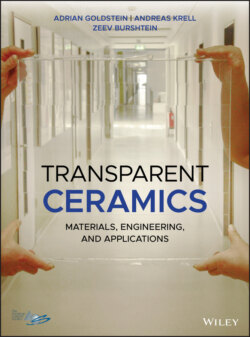Читать книгу Transparent Ceramics - Adrian Goldstein - Страница 10
Foreword
ОглавлениеWho had imagined in 1964 that the first solid-state laser of Nd3+-doped Y3Al5O12 (YAG) single crystals might be replaced by Nd3+-doped YAG transparent laser ceramics? Requests to fabricate such transparent ceramics are at the frontier of materials science and everyone considered at this time that transparent ceramic materials could not be used for laser or optical materials. However, dreams came true in 1995 and now garnet transparent laser ceramics are commercialized and have been extended also to Ce3+-doped YAG as phosphors associated with blue LED for high power white lighting. Recently, the list of application of transparent ceramics, for which some of them are highly sophisticated, for laser media, phosphors, scintillators, armor windows, infrared domes, and electro-optical components have widely increase in all domains and have impacted our daily life.
This book addresses precise topics on available transparent ceramics (TCs) materials, how they are processed, their applications, and aspects of the progress made in their engineering as well as our scientific understanding. Adrian Goldstein, Andreas Krell, and Zeev Burshtein, well-known authorities in the international community of the ceramics, animated during all their scientific lives by the passion of the field and the desire to communicate it, were able to pause and review carefully the accomplishments of this period, the remaining challenges, and future prospects.
Clearly, the data presented are well explained, in correlation with the theoretical science and engineering background. This book answers well with the evolution of the transparent ceramics so that it will successfully help students and researchers for any developments still in a laboratory stage. As an example, data help to understand relationships between microstructures (porosity and size distribution of pores) and optical properties, and also processing strategies of densification and transparency. Their upgrading in the near future has to be relevant for industrial operations and will likely lead to significantly strengthen the economic relevance of the transparent ceramics.
Students, scientists, and engineers working with ceramics should get this book providing extensive references to contemporary works and being a basis for studying the field. It covers applications through detailed case studies and therefore a comprehensive guide to the current status of transparent ceramics, well suited to readers who wish to use it, either to understand these materials or to solve specific problems.
UCB Lyon 1, France
Georges Boulon
Emeritus Professor
